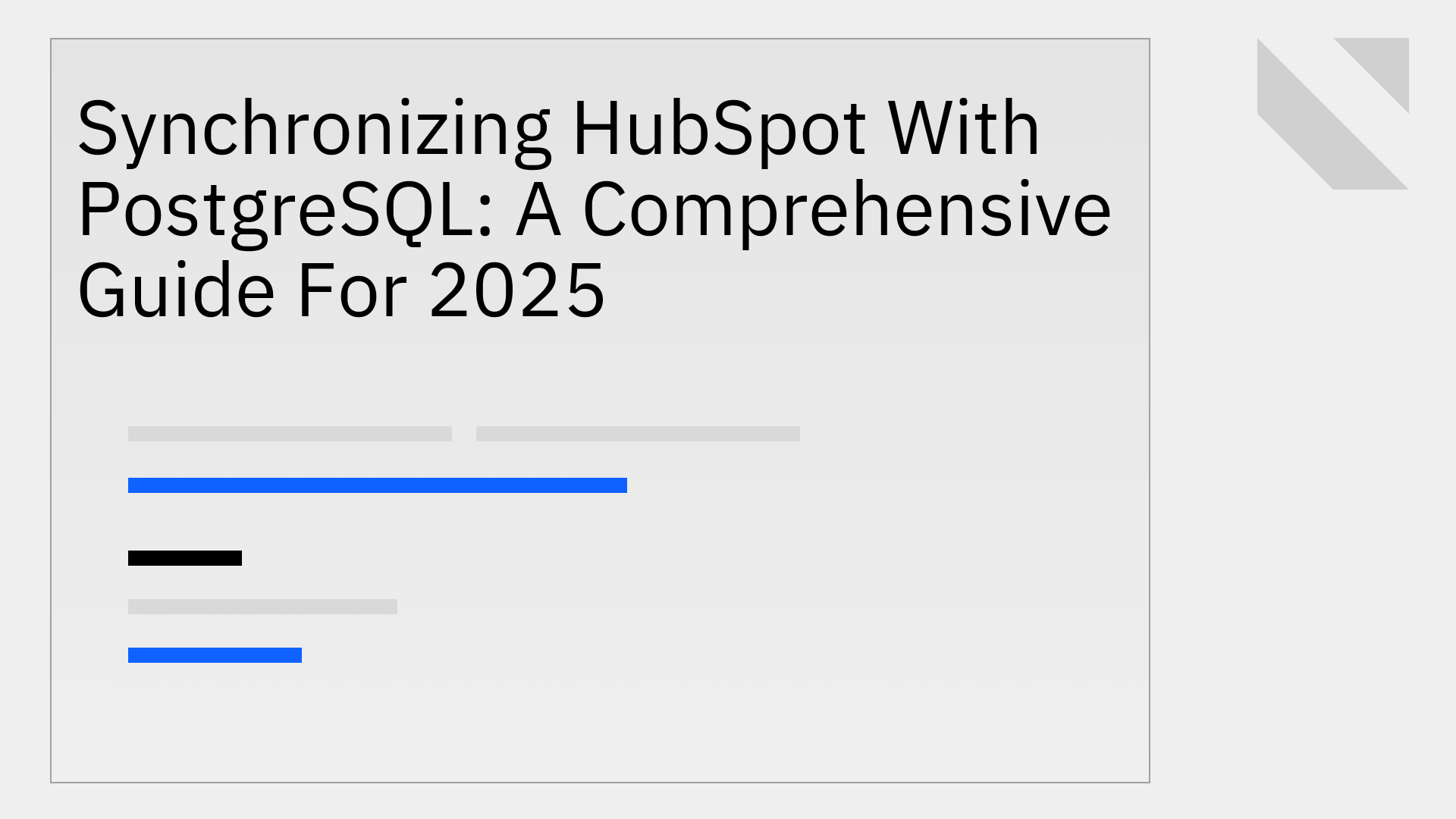

In 2025, PostgreSQL HubSpot CRM integration is critical for eliminating silos, reducing duplicate data, and enabling real-time decisions. With two-way sync, updates in HubSpot instantly reflect in PostgreSQL and vice versa, so sales, marketing, and operations always work with accurate information.
This guide explains how to set up, optimize, and scale a reliable integration.
HubSpot is a cloud-based customer relationship management (CRM) platform used to manage sales, marketing, and customer service activities. PostgreSQL is an open-source relational database used to store and query structured data.
Key business benefits:
For example, a software company might sync customer information from HubSpot to PostgreSQL to combine it with product usage data. This gives them a complete view of how customers interact with both sales teams and their product.
There are three main ways to connect HubSpot with PostgreSQL, each with different technical requirements:
In 2025, Stacksync stands out by offering real-time, bi-directional sync with sub-second latency, something tools like Fivetran or Zapier can’t fully deliver (Fivetran itself clarifies it focuses on ELT pipelines into a destination, not bi-directional sync
The simplest method involves exporting data files from HubSpot and importing them into PostgreSQL.
To export from HubSpot:
To import into PostgreSQL, use the COPY command (explained in the PostgreSQL COPY documentation)
COPY contacts FROM '/path/to/file.csv' DELIMITER ',' CSV HEADER;
This approach works for occasional updates but becomes time-consuming if done frequently. It also lacks automation, requiring someone to manually perform each export and import.
For more automated syncs, developers can write code that connects directly to HubSpot's API to retrieve data and insert it into PostgreSQL.
A simple Python example might look like:
import requests
import psycopg2
# Get data from HubSpot
headers = {"Authorization": "Bearer YOUR_TOKEN"}
response = requests.get("https://api.hubapi.com/crm/v3/objects/contacts", headers=headers)
contacts = response.json()["results"]
# Connect to PostgreSQL and insert data
conn = psycopg2.connect("dbname=mydatabase user=myuser")
cursor = conn.cursor()
for contact in contacts:
cursor.execute(
"INSERT INTO contacts (id, email, firstname) VALUES (%s, %s, %s)",
(contact["id"], contact["properties"]["email"], contact["properties"]["firstname"])
)
conn.commit()
This method requires programming skills but offers more control over what data syncs and when.
ETL (Extract, Transform, Load) tools provide ready-made connectors for both HubSpot and PostgreSQL. These tools handle the technical details of connecting systems, mapping fields, and scheduling regular updates.
Popular options include:
These platforms typically offer user-friendly interfaces where you can select which HubSpot objects to sync, map fields to PostgreSQL columns, and set up automatic sync schedules.
Two-way sync (bidirectional synchronization) means changes in either system update the other system automatically. This differs from one-way sync, where data flows in only one direction.
How two-way sync works:
Setting up two-way sync requires:
For HubSpot and PostgreSQL, this typically involves:
When both systems can change the same data, conflicts inevitably arise. For example, a sales rep might update a contact's phone number in HubSpot while a database admin corrects the same field in PostgreSQL.
How to Handle Conflicts in PostgreSQL HubSpot CRM Integration
Document rules clearly to avoid confusion across teams.
Whatever strategy you choose, document it clearly so everyone knows which system to update for specific types of data.
When syncing sensitive customer data between systems, security becomes paramount.
Key security considerations:
For data integrity, implement these safeguards:
Many organizations encounter similar challenges when setting up HubSpot to PostgreSQL syncs.
Problem: The same contact appears multiple times in either system.
Solution: Establish a unique identifier (usually email for contacts, domain for companies) and use "upsert" operations (update if exists, insert if not) rather than always inserting.
Problem: Adding custom properties in HubSpot or columns in PostgreSQL breaks the sync.
Solution: Design your sync to detect schema changes and either adapt automatically or notify administrators. Make schema changes in a controlled manner, updating the sync configuration accordingly.
Problem: HubSpot limits how many API calls you can make per day.
Solution: Implement these strategies to work within limits:
Successful HubSpot to PostgreSQL synchronization depends on thoughtful planning and implementation. The most effective integrations:
In 2025, a robust PostgreSQL HubSpot CRM integration is no longer optional—it’s the backbone of unified operations. The best integrations deliver:
Traditional ETL pipelines or manual scripts can’t match this.
Tools like Stacksync offer a faster, enterprise-ready solution, replacing brittle custom code with reliable, no-code real-time sync.